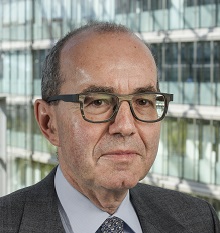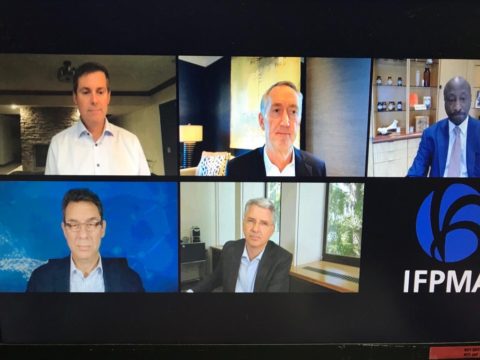Last week, IFPMA hosted the fifth and last CEO COVID-19 media briefing of 2020 with CEOs and top executives from Eli Lilly and Company, Johnson & Johnson, Pfizer and Roche. I joined the CEOs as they shared their take on progress achieved in 2020 and insights into 2021 and beyond. With this blog, I wanted to share with you some of the highlights of the briefing.
Leading the charge against COVID-19
Over the past 10 months, life as we knew it came to a grinding halt. From the onset of the pandemic, the biopharmaceutical industry sprinted into action and began mobilizing its resources and partnering like never before to develop COVID-19 technologies to help provide solutions. From repurposed and new treatments, to novel vaccines and diagnostics, the industry’s top priority became, and still is, devoting its resources, expertise, know-how, and intellectual assets to fight COVID-19.
2020 has been a year for the history books. Our latest media briefing on 8 December, was witness of how we have walked the talk – how we have lived up to our responsibilities – how we have worked in partnership like we have never done before. For the first time since the virus was shared, we see light at the end of the tunnel.
Albert Bourla, Chairman and Chief Executive Officer of Pfizer said during the briefing “if I look back from March to today, one lesson that stands out is the power of science. And that applies to the entire spectrum of COVID, and that applies also to us. Without our science, we wouldn’t be able to do anything in such a short period of time”.
The unprecedented collaboration from the industry has already proven fruitful with three vaccines in the process of being approved by regulators. In the coming months, this number could increase to as many as ten, proving much needed comfort and hope of finding a lasting solution for the pandemic. As Paul Stoffels, Chief Scientific Officer of Johnson & Johnson said, “with a both stable and transportable vaccine, we’ll be able to make a big difference in the world”. To ensure that vaccines developed are suitable for the global population, vaccine makers have ensured that clinical trial participants are diverse and addresses high-risk populations such as the elderly, people with co-morbidities and certain ethnic groups in parts of the world.
What has gotten us here is the ability to work towards a common goal. Paul Stoffels stressed that high regulatory standards are being upheld and maintained and “no corners are cut” as vaccine hesitancy rates increase, in part due to a parallel pandemic of misinformation. He explained that process as “a huge amount of work in a small amount of time with extreme supervision from regulators which is very transparent but also very fast”. Vaccines makers are able to work in parallel, speeding up the overall time needed, and regulatory bodies have also increased their turn around time and in some cases are able to respond within 24 hours, cutting a lot of time out of the process.
The road ahead
We still have a long road ahead. As we take in the good news about the first persons being vaccinated, we must also think how to best ensure that no one is left behind. As long as COVID-19 exists in one corner of the world, it will continue to pose a threat to us all. Equitable access to COVID-19 vaccines, treatments and diagnostics is paramount. The industry stands by its commitment to fair and equitable access to COVID-19 products, working in partnership with the ACT-Accelerator. Several major companies have pledged to offer their vaccines on a not-for-profit basis during the pandemic. Others are considering differential pricing for different countries. As of last month, four major pharmaceutical companies had already agreed to eventually produce at least three billion vaccine doses for low- and middle-income nations.
The way to do this cannot be, as some have suggested, to pull the rug under the feet of research scientists.
Take “messenger RNA,” the technology platform that supports the vaccines from Pfizer/BioNTech and Moderna. A technology that being explored more than more than 25 years ago, successfully used for the first time against COVID-19.
Intellectual property is the blood of the private sector. I echo what industry representatives have said on the call with journalists: IP is what brought the solution to this pandemic. Patents and intellectual property remain the lifeline for future pandemic preparedness and allow companies to operate at never-before-seen speeds and invest heavily in risky research without any guaranteed reward.
Vaccines are here. Now for the hard part … we still have a great uphill battle to manufacture and distribute them across the world. The reality is that we will still have to live with this pandemic for some time. David Ricks, Chief Executive Officer of Eli Lilly discussed that production capacities of vaccines and treatments remains a barrier. Both David Ricks and Severin Schwan pointed out that a key constraint to providing enough monoclonal antibodies is the manufacturing capacity. Both Roche and Eli Lilly are leveraging any capacity they can find within their networks to increase the specialist production of monoclonal antibodies.
COVID-19 vaccines and treatments are part of the solution, but Severin Schwan, Chief Executive Officer of Roche & Vice-President of IFPMA stressed that “diagnostics will remain important – not only for the months to come, but for the years to come”.
No one entity alone can bring an end to the pandemic and the successes we have seen thus far is by in large attributed to the engineers, scientists and everybody working on this. I have a tremendous amount of great respect to the health care workers on the front line, who truly deserve to get those vaccines early on.







